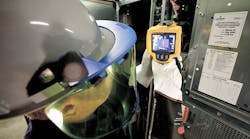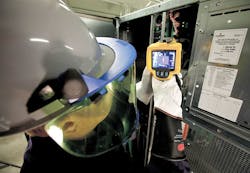Chapter 1 of NFPA 70E, Standard for Electrical Safety in the Workplace, covers electrical safety-related work practices and procedures [105.1]. These apply where employees are exposed to electrical hazards within the scope of NFPA 70E. The “are exposed” is often presumed. For example, if equipment has not been maintained, you presume a hazard exists [Table 130.7(C)(15)(A)(a)]. The statement of scope [90.2] is similar to its NEC counterpart. Assume your work is within that scope unless it falls under the “Not Covered” situations listed in 90.2(B). Note that NFPA 70E does not replace OSHA requirements, but it supplements them [110.1(A)].
The majority of the general requirements section applies to employer responsibilities. If you’re in management and your people perform electrical work, this material is critical to understand.
Most of what’s in the general requirements section applies to employer responsibilities. If you’re in management and your people perform electrical work, this material is obviously critical for you to understand.
If you’re not a manager, why should you care what’s in here? Think about the list below. Can you add more to it?
- It will help you understand and follow your employer’s safety program.
- Your employer’s safety program may have problems you can identify and get resolved.
- You may be called upon to supervise, and you’ll be prepared to step up.
- When you accept responsibility for understanding the basis for your employer’s safety program, your own safety mind-set is reinforced. That can make the difference between walking out the door or being carried out.
Maintenance
In the general requirements section, NFPA 70E briefly mentions that the safety program must consider equipment maintenance [110.1(B)]. This concept appears elsewhere in the standard, too.
For example, browse through Table 130.7(C)(15)(A)(a) Arc Flash Hazard Identification for Alternating Current (AC) and Direct Current (DC) Systems, and you repeatedly see this phrase in the Equipment Condition column: “The equipment is properly maintained.” Its opposite, “The equipment is not properly maintained,” is also repeatedly shown here.
Why would the condition of the equipment maintenance matter? Let’s consider one task in that table: “Normal operation of a circuit breaker, switch, contactor, or starter.” These devices open and close a circuit. When properly maintained, they do so safely.
But what if a circuit breaker has not been lubricated or exercised for a few years? Will it operate smoothly? Probably not. Because that increases the risk of arc flash, arc flash PPE is required.
Consider maintenance generally. Your electrical services firm sends you on a thermography job. Being conscientious, you ask your host about their feeder maintenance program and how many feeders were identified as suspect during the last insulation resistance testing work. The reply is they don’t have such a program and don’t perform insulation resistance testing. So you have no clue about the insulation integrity of the cables you’ll be exposing yourself to during the thermography. You must stop at that point to conduct an electrical hazard assessment on the presumption that all of the cables are faulty. You must assume the equipment is in an abnormal, damaged condition unless you have maintenance data showing otherwise.
Some people believe it makes more sense to assume in the other direction. An abnormal condition is, by definition, less likely to exist than a normal condition. But this isn’t about guessing how likely the abnormal condition might be. You don’t want to walk into an abnormal condition unprepared. You want to be able to walk back out, so you prepare accordingly.
You also can’t just assume the mere existence of a maintenance program means the equipment is properly maintained. The following may help clue you in:
- The maintenance practices and frequencies follow the established guidelines provided by industry standards.
- Those performing the maintenance are qualified to do so. They have the specific training and experience to correctly perform the specific maintenance tasks they are assigned.
- The correct test equipment is used, and it is properly calibrated / maintained.
- You can find the drawings!
Awareness and self-discipline
The traditional model of safety administration is:
- Tell the employees what to do.
- Hope they follow the rules.
- Hope the rules cover everything.
NFPA 70E completely changes this to a model that depends on:
- Training the employees in safety principles [110.1(C)].
- Making them aware of the hazards.
- Instilling in them the self-discipline to follow those principles and protect themselves against those hazards.
The employee no longer looks at the rules to see what he can get by with. The employee now understands and implements the safety principles that help him identify the possible hazards and protect himself from them.
The safety program must identify the principles [110.1(D)], controls [110.1(E)], and program procedures [110.1(F)] upon which it is based. Three other requirements are a risk assessment procedure [110.1(G)], a job briefing [110.1(H)], and electrical safety auditing [110.1(I)].
Training requirements
Gone are the days of dog and pony show “safety training” that is more concerned with being able to check off the box for legal purposes than ensuring the employee is properly qualified to safely perform the work. It’s no longer good enough that the employee has been told, and we’re good to go now. The employee must now understand the principles and the hazards, and only then are we good to go.
Simply telling people the safety requirements can be done quickly and with little effort. Ensuring they understand [110.2(A)] takes much more time and effort. In fact, practical demonstration of that understanding is now a requirement [110.2(D)(1)(c)]. And not just once; retraining is also required [110.2(D)(3)]. When this proficiency is demonstrated, it must be documented [110.2(E)].
If you’re the manager in charge of implementing a training program that meets these requirements, you should really think it through. How do you ensure the principles are understood? What constitutes a valid practical demonstration? Who determines whether an employee passes or fails such a demonstration, and what are that person’s qualifications for doing so?
If you’re the employee being trained, don’t just accept that the program is complete and correct. Look for holes in the program. Any such holes put you at risk; make a point of speaking up any time you don’t understand something or it’s been taught but you’re not tested on it. Keep in mind that if you see a hole in the program, another employee stepping through it can put you at risk.
With the 2015 edition, the requirements for emergency response training have been expanded to include training for first aid, emergency response, and resuscitation. Is your program updated to conform to these requirements if it didn’t previously include them?
Host employer duties
If your company engages outside firms to perform electrical work in your facility, it makes your company a “host employer” to the employees of those firms. This means you must inform the contractor employees of the known hazards related to their work and provide them with information about your installation so they can make the assessments required by Chapter 1 of NFPA 70E [110.3(A)(1)]. A common practice for compliance is to put all employees (contract or inhouse) through the same training for the same hazards.
But the contractors may face additional hazards simply because they are performing work the in-house people don’t perform. So augment the “same as inhouse” training with training specific to the work the contractors are performing.
Suppose your company engages an electrical testing firm for your annual shutdown. They’re going to test a large number of cables, plus perform the recommended maintenance testing on your switchgear. What are your duties as the host employer? Keep in mind, it’s your facility. The contractor employees must follow your rules. If they don’t, which outcome is less desirable?
- A fatality and possible extended shutdown due to continued unsafe acts, or
- A project delay while you stop work to correct the problem.
In the worst case, you fire the contractor for not following your rules. If you’ve properly vetted your contractors, you shouldn’t have a worst case. But you might have to stop work until the contractor provides an acceptable solution, such as replacing the unsafe employees on their crew.
Contract employer duties
Suppose your firm is the contractor. What are your duties then? NFPA 70E requires you to ensure each of your employees gets the training the host employer is required to provide [110.3(B)].
If you’ve been an electrical contractor for any length of time, you have seen things that make you wonder if a qualified electrician ever got near the place. What are the implications of that when it comes to the safety of your employees?
Don’t trust the host employer to cover everything. Instead, take the time to go over their program with them to ensure it’s complete.
Once your employees are properly trained, your responsibility then shifts to ensuring they are following the work practices required by NFPA 70E and by the host employer [110.3(B)(2)].
Enable them. With the 2015 edition of NFPA 70E, the focus of safety training is clearly different from the traditional focus. Now you focus on providing employees with an understanding of how to identify and protect against electrical hazards. Properly executed, an NFPA 70E-compliant program enables people to work safely whether an applicable rule exists or not.
Lamendola is an electrical consultant located in Merriam, Kan. He can be reached at comments@mindconnection.com.





